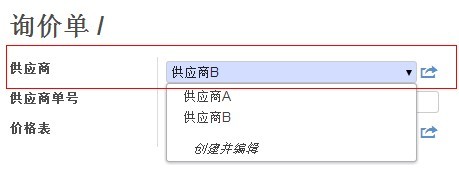openerp学习笔记 对象间关系【多对一(一对一)、一对多(主细结构)、多对多关系、自关联关系(树状结构)】
1.多对一(一对一)关系:采购单与供应商之间的关系
'partner_id':fields.many2one('res.partner', 'Supplier', required=True, states={'confirmed':[('readonly',True)], 'approved':[('readonly',True)],'done':[('readonly',True)]},
change_default=True, track_visibility='always'),
典型的录入界面:
2.一对多(主细结构)关系:采购单主表与采购单明细表之间的关系
'order_line': fields.one2many('purchase.order.line', 'order_id', 'Order Lines', states={'approved':[('readonly',True)],'done':[('readonly',True)]}),
典型的录入界面:
对应的XML定义:
<page string="Purchase Order"> <field name="order_line"> <tree string="Purchase Order Lines" editable="bottom"> <field name="product_id" on_change="onchange_product_id(parent.pricelist_id,product_id,0,product_uom,parent.partner_id, parent.date_order,parent.fiscal_position,date_planned,name,price_unit,context)"/> <field name="name"/> <field name="date_planned"/> <field name="company_id" groups="base.group_multi_company" widget="selection"/> <field name="account_analytic_id" groups="purchase.group_analytic_accounting" domain="[('type','not in',('view','template'))]"/> <field name="product_qty" on_change="onchange_product_id(parent.pricelist_id,product_id,product_qty,product_uom,parent.partner_id,parent.date_order,parent.fiscal_position,date_planned,name,price_unit,context)"/> <field name="product_uom" groups="product.group_uom" on_change="onchange_product_uom(parent.pricelist_id,product_id,product_qty,product_uom,parent.partner_id, parent.date_order,parent.fiscal_position,date_planned,name,price_unit,context)"/> <field name="price_unit"/> <field name="taxes_id" widget="many2many_tags" domain="[('parent_id','=',False),('type_tax_use','!=','sale')]"/> <field name="price_subtotal"/> </tree> </field> <group class="oe_subtotal_footer oe_right"> <field name="amount_untaxed" widget="monetary" options="{'currency_field': 'currency_id'}"/> <field name="amount_tax" widget="monetary" options="{'currency_field': 'currency_id'}"/> <div class="oe_subtotal_footer_separator oe_inline"> <label for="amount_total"/> <button name="button_dummy" states="draft" string="(update)" type="object" class="oe_edit_only oe_link"/> </div> <field name="amount_total" nolabel="1" class="oe_subtotal_footer_separator" widget="monetary" options="{'currency_field': 'currency_id'}"/> </group> <div class="oe_clear"/> <field name="notes" class="oe_inline" placeholder="Terms and conditions..."/> </page>
反过来,采购单明细与采购单主表之间为多对一关系
'order_id': fields.many2one('purchase.order', 'Order Reference', select=True, required=True, ondelete='cascade'),
其中 ondelete='cascade' 表示开启级联删除,即删除采购单主表时自动删除采购单明细表。
3.多对多关系:客户与客户类型之间的关系,自动生成关联表 res_partner_res_partner_category_rel
'category_id': fields.many2many('res.partner.category', id1='partner_id', id2='category_id', string='Tags'),
典型的录入界面1:
对应的XML定义:
<field name="category_id" widget="many2many_tags" placeholder="Tags..."/>
典型的录入界面2:
对应的XML定义:
<page string="库位操作范围">
<field name="location_ids" nolabel="1" />
</page>
4.自关联关系:OpenERP客户与联系人之间的关系,res.partner 与 res.partner 自关联产生 many2one 关系(parent_id)和 one2many 关系(child_ids)
class res_partner(osv.osv, format_address):
_description = 'Partner'
_name = "res.partner"
# indirection to avoid passing a copy of the overridable
method when declaring the function field
_commercial_partner_id = lambda self, *args, **kwargs:
self._commercial_partner_compute(*args, **kwargs)
_order = "name"
_columns =
{
'name': fields.char('Name',
size=128, required=True,
select=True),
'date':
fields.date('Date', select=1),
'title': fields.many2one('res.partner.title',
'Title'),
'parent_id':
fields.many2one('res.partner', 'Related
Company'),
'child_ids':
fields.one2many('res.partner', 'parent_id', 'Contacts',
domain=[('active','=',True)]), # force "active_test" domain to bypass _search()
override
'ref':
fields.char('Reference', size=64,
select=1),
'lang':
fields.selection(_lang_get,
'Language',
help="If the selected language is loaded in the system, all documents related to
this contact will be printed in this language. If not, it will be
English."),
'tz':
fields.selection(_tz_get, 'Timezone',
size=64,
help="The partner's timezone, used to output proper date and time values inside
printed reports.
"
"It is important to set a value for this field. You should use the same timezone
"
"that is otherwise used to pick and render date and time values: your computer's
timezone."),
'tz_offset':
fields.function(_get_tz_offset, type='char', size=5, string='Timezone offset',
invisible=True),
'user_id':
fields.many2one('res.users', 'Salesperson', help='The internal user that is in
charge of communicating with this contact if
any.'),
'vat': fields.char('TIN',
size=32, help="Tax Identification Number. Check the box if this contact is
subjected to taxes. Used by the some of the legal
statements."),
'bank_ids':
fields.one2many('res.partner.bank', 'partner_id',
'Banks'),
'website':
fields.char('Website', size=64, help="Website of Partner or
Company"),
'comment':
fields.text('Notes'),
'category_id': fields.many2many('res.partner.category', id1='partner_id',
id2='category_id',
string='Tags'),
'credit_limit': fields.float(string='Credit
Limit'),
'ean13':
fields.char('EAN13', size=13),
'active':
fields.boolean('Active'),
'customer': fields.boolean('Customer', help="Check this box if this contact is a
customer."),
'supplier':
fields.boolean('Supplier', help="Check this box if this contact is a supplier.
If it's not checked, purchase people will not see it when encoding a purchase
order."),
'employee':
fields.boolean('Employee', help="Check this box if this contact is an
Employee."),
'function':
fields.char('Job Position',
size=128),
'type':
fields.selection([('default', 'Default'), ('invoice',
'Invoice'),
('delivery', 'Shipping'), ('contact',
'Contact'),
('other', 'Other')], 'Address
Type',
help="Used to select automatically the right address according to the context in
sales and purchases documents."),
'street': fields.char('Street',
size=128),
'street2':
fields.char('Street2', size=128),
'zip': fields.char('Zip', change_default=True,
size=24),
'city':
fields.char('City', size=128),
'state_id': fields.many2one("res.country.state",
'State'),
'country_id':
fields.many2one('res.country',
'Country'),
'country':
fields.related('country_id', type='many2one', relation='res.country',
string='Country',
deprecated="This field will be removed as of OpenERP 7.1, use country_id
instead"),
'email':
fields.char('Email', size=240),
'phone': fields.char('Phone',
size=64),
'fax':
fields.char('Fax', size=64),
'mobile': fields.char('Mobile',
size=64),
'birthdate':
fields.char('Birthdate', size=64),
'is_company': fields.boolean('Is a Company', help="Check if the contact is a
company, otherwise it is a
person"),
'use_parent_address':
fields.boolean('Use Company Address', help="Select this if you want to set
company's address information for this
contact"),
# image: all image
fields are base64 encoded and
PIL-supported
'image':
fields.binary("Image",
help="This field holds the image used as avatar for this contact, limited to
1024x1024px"),
'image_medium':
fields.function(_get_image,
fnct_inv=_set_image,
string="Medium-sized image", type="binary",
multi="_get_image",
store={
'res.partner': (lambda self, cr, uid, ids, c={}: ids, ['image'],
10),
},
help="Medium-sized image of this contact. It is automatically
"\
"resized as a 128x128px image, with aspect ratio preserved.
"\
"Use this field in form views or some kanban
views."),
'image_small':
fields.function(_get_image,
fnct_inv=_set_image,
string="Small-sized image", type="binary",
multi="_get_image",
store={
'res.partner': (lambda self, cr, uid, ids, c={}: ids, ['image'],
10),
},
help="Small-sized image of this contact. It is automatically
"\
"resized as a 64x64px image, with aspect ratio preserved.
"\
"Use this field anywhere a small image is
required."),
'has_image':
fields.function(_has_image,
type="boolean"),
'company_id':
fields.many2one('res.company', 'Company',
select=1),
'color':
fields.integer('Color Index'),
'user_ids': fields.one2many('res.users', 'partner_id',
'Users'),
'contact_address':
fields.function(_address_display, type='char', string='Complete
Address'),
# technical field used for
managing commercial fields
'commercial_partner_id': fields.function(_commercial_partner_id,
type='many2one', relation='res.partner', string='Commercial
Entity'),
'create_uid':
fields.many2one('res.users', u"创建用户", invisible=False, readonly=True),
#需要在记录中读取该字段或者在视图、打印中显示该字段时,对象中必须包含
}
5.自关联关系(树状结构,无限级):产品类别与父级类别之间的关系,product.category 与 product.category 自关联产生 many2one 关系(parent_id)和 one2many 关系(child_id)
class product_category(osv.osv):
def name_get(self, cr, uid, ids,
context=None):
if
isinstance(ids, (list, tuple)) and not
len(ids):
return []
if isinstance(ids,
(long,
int)):
ids
= [ids]
reads = self.read(cr, uid,
ids, ['name','parent_id'],
context=context)
res =
[]
for record in
reads:
name =
record['name']
if
record['parent_id']:
name = record['parent_id'][1]+' /
'+name
res.append((record['id'], name))
return res
def _name_get_fnc(self, cr, uid, ids,
prop, unknow_none, context=None):
res = self.name_get(cr, uid, ids,
context=context)
return
dict(res)
_name = "product.category"
_description = "Product Category"
_columns =
{
'name': fields.char('Name',
size=64, required=True, translate=True,
select=True),
'complete_name': fields.function(_name_get_fnc, type="char",
string='Name'),
'parent_id':
fields.many2one('product.category','Parent Category', select=True,
ondelete='cascade'),
'child_id':
fields.one2many('product.category', 'parent_id', string='Child
Categories'),
'sequence':
fields.integer('Sequence', select=True, help="Gives the sequence order when
displaying a list of product
categories."),
'type':
fields.selection([('view','View'), ('normal','Normal')], 'Category Type',
help="A category of the view type is a virtual category that can be used as the
parent of another category to create a hierarchical structure."),
'parent_left':
fields.integer('Left Parent', select=1),
'parent_right': fields.integer('Right Parent',
select=1),
}
_defaults =
{
'type' : lambda *a :
'normal',
}
_parent_name = "parent_id"
_parent_store = True
_parent_order = 'sequence,
name'
_order = 'parent_left'
def _check_recursion(self, cr, uid, ids,
context=None):
level =
100
while
len(ids):
cr.execute('select distinct parent_id from product_category where id IN
%s',(tuple(ids),))
ids = filter(None, map(lambda x:x[0],
cr.fetchall()))
if not
level:
return
False
level -= 1
return True
_constraints =
[
(_check_recursion, 'Error ! You
cannot create recursive categories.',
['parent_id'])
]
def
child_get(self, cr, uid, ids):
return [ids]
product_category()


